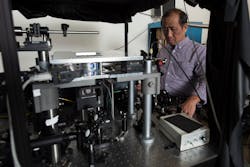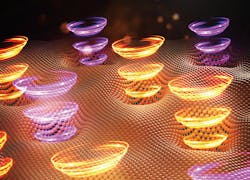Chiral quantum light emitter generates single photons, controls chirality, to encode data
In a huge step toward enabling quantum sensing and information processing technologies, a team of Los Alamos National Laboratory (LANL; Los Alamos, NM) researchers created a chiral quantum light source by stacking two different atomically thin materials together to generate a stream of circularly polarized single photons (see video).
Quantum light emitters or single photon emitters produce a stream of individual photons in regular intervals akin to soldiers marching in a single column.
“You can’t make a quantum light source by simply dimming a normal fluorescence lamp because billions of light-emitting molecules within the fluorescence lamp emit photons at random, like people rushing out of a stadium after the game,” says Han Htoon, a scientist at LANL, whose team has been working within this realm for more than 20 years (see Fig. 1).
Instead, the goal is to get a single atom to emit a stream of single photons. Think of a solid-state quantum emitter as an artificial system capable of mimicking the behaviors of an individual atom.
“Once a stream of single photons is generated, an ability to manipulate whether the electromagnetic field of the photons is rotating clockwise or counterclockwise—the chirality of photons—becomes essential for encoding quantum information in the photon stream,” explains Htoon. “Achieving such manipulation usually requires coupling the quantum emitter to very complex photonic or electronic nanoscale devices or applying very high magnetic fields generated by bulky magnets.”
Nanoscale device generates stream of photons, controls chiral quantum light
The team created a single nanoscale device capable of not only generating a stream of single photons, but also controlling the chirality of the photons. This amazing two-fer involves stacking two different materials (see Fig. 2): a single molecular-layer-thick tungsten di-selenide semiconductor (WSe2) and a thin nickel-phosphorous trisulfide (NiPS3) magnetic crystal, and then pressing the two materials together with an atomic force microscopy (AFM) tip to form nanoscale indentations.
“Our nanoscale strain engineering with the AFM tip has induced two important changes in both the WSe2 layer and the NiPS3 crystal—leading to the formation of chiral quantum light emitters,” says Htoon. “First, the strain from the indentation creates a potential well that quantum mechanically confines electron-hole pairs (excitons) within the WSe2 monolayer to discrete quantum states capable of emitting a stream of single photons.”
At the same location, the nano-indent disrupts the alignment of magnetic moments in the NiPS3 crystal—creating a tiny magnet. “As a result, a quantum-state emitting single photons and a local magnetic moment required for circularly polarizing the photons are created in close proximity to each other. This synergy results in the emission of chiral quantum light,” Htoon says.
Another way of looking at this is that individuals often adopt behaviors of the people within their close proximity—and changes in behavior due to proximity can also occur in the quantum mechanical world. “It’s known as the proximity effect and it allows one material to borrow a property from another,” Htoon says. “We showed that by inducing the strain in nanoscale incident, we can localize this proximity effect to nanometer-length scale—leading to the generation of chiral quantum light. It’s the most innovative aspect of our work.”
A surprising discovery
The most surprising aspect of the team’s work was “the realization of this highly desirable chiral quantum light emission in this WSe2/NiPS3 material combination,” says Htoon. “Emission of chiral light requires a magnetic field pointing perpendicular to the plane of the sample to introduce an energy splitting between the quantum mechanical states that couple to left and right chiral light.”
For this reason, previous experiments used ferromagnetic materials where all the spins of the magnetic ions are aligned together to point out of the plane. But NiPS3 is an antiferromagnetic semiconductor in which the spins of a row of nickel ions align in an antiparallel manner with those of the adjacent row. As a result, the magnetic moments of the nickel atoms naturally cancel each other out—leading to no out-of-plane magnetization.
“Our initial experiments yielded disappointing results,” Htoon says. “Coupling a WSe2 monolayer to the NiPS3 substrate resulted only in partial quenching of the WSe2 photoluminescence (PL) emission, and the PL exhibited no circular polarization.”
Despite this, Xiangzhi Li, the postdoc spearheading the experiment, made one more attempt with a slight twist in this material combination. He used AFM to create a series of nanometer-scale indentations in the WSe2-NiPS3 stack, using nanoscale strain engineering.
“Surprisingly, this time, we observed emission of strongly circularly polarized single photons from the nanoscale indents,” says Htoon. “To the best of our knowledge, such a strong effect has never been observed in any other system. We didn’t even believe our own experiment at that moment and went on to conduct a series of controlled experiments to confirm our findings.”
Confirmation of results
After the team’s discovery, they faced an even bigger challenge confirming their hypothesis that the chiral quantum light emission they observed is a result of the proximity between the quantum light emitting state of WSe2 and the local magnetic moment of NiPS3.
“First, our team member Scott Crooker of the National High Magnetic Field Laboratory at LANL, suggested a temperature-dependent photoluminescence experiment in a high magnetic field to show that the observed chiral quantum light emission is directly linked to the antiferromagnetic arrangement of spins in NiPS3 crystal,” says Htoon. “Then we collaborated with Patrick Maletinsky’s group at the University of Basel in Switzerland to perform scanning diamond nitrogen-vacancy center microscopy on an indented NiPS3 crystal. The experiment revealed a small out-of-plane magnetization along the edge of the indentation, confirming that the disturbance of the antiferromagnetic order indeed leads to some localized out-of-plane magnetic moments.”
Modulating the degree of circular polarization of single photons
The team is currently exploring ways to modulate the degree of circular polarization of the single photons with the application of electrical, optical, or microwave stimuli, because this capability would offer a way to encode quantum information into the photon stream.
“Further coupling of the photon stream into waveguides—microscopic conduits of light—would provide the photonic integrated circuits that allow the propagation of photons in one direction,” says Htoon. “Such circuits would be the fundamental building blocks of an ultrasecure quantum internet.”
FURTHER READING
X. Li et al., Nat. Mater. (2023); https://doi.org/10.1038/s41563-023-01645-7.
About the Author
Sally Cole Johnson
Editor in Chief
Sally Cole Johnson, Laser Focus World’s editor in chief, is a science and technology journalist who specializes in physics and semiconductors.


